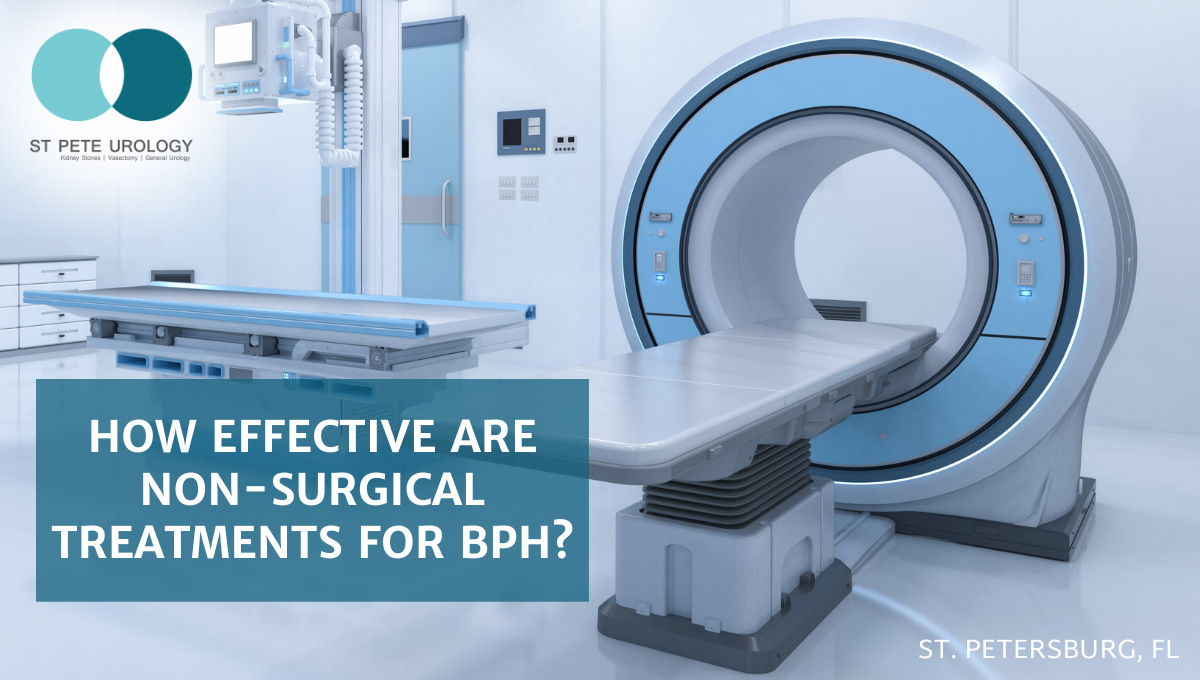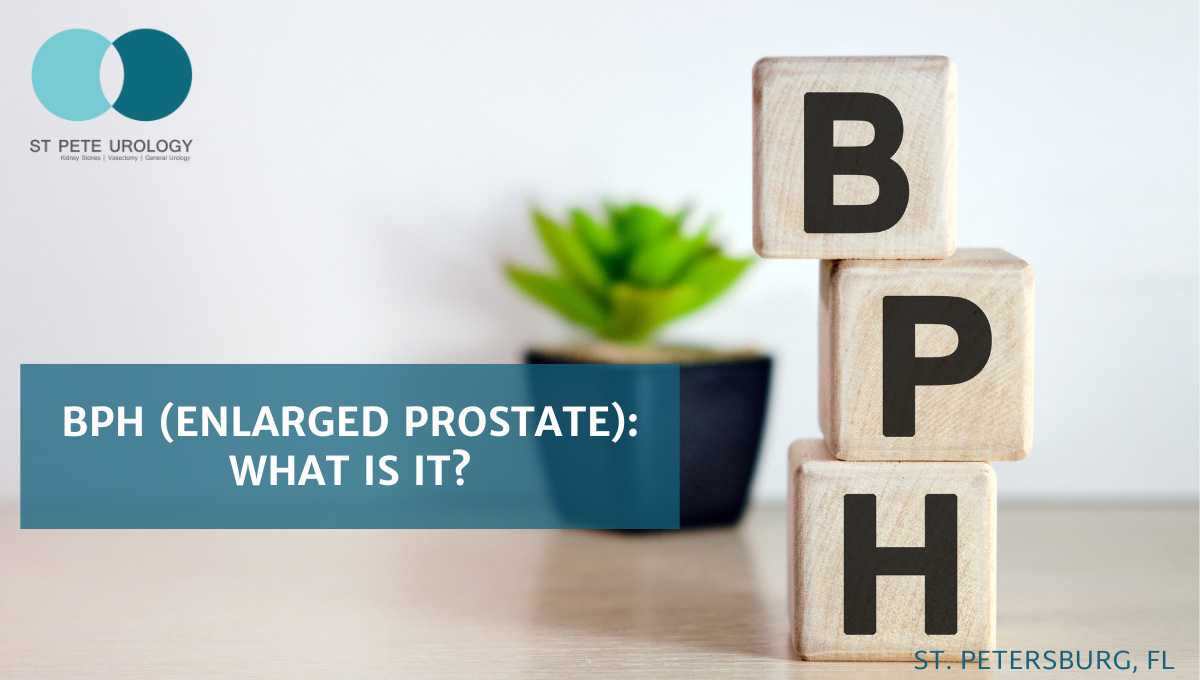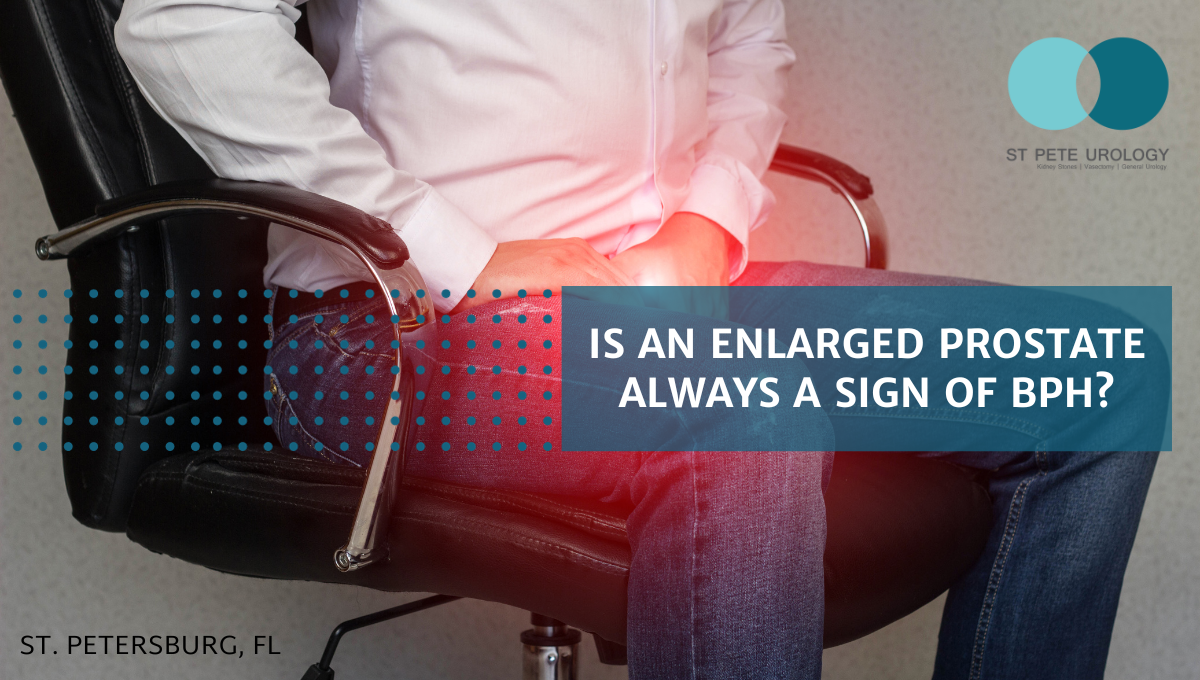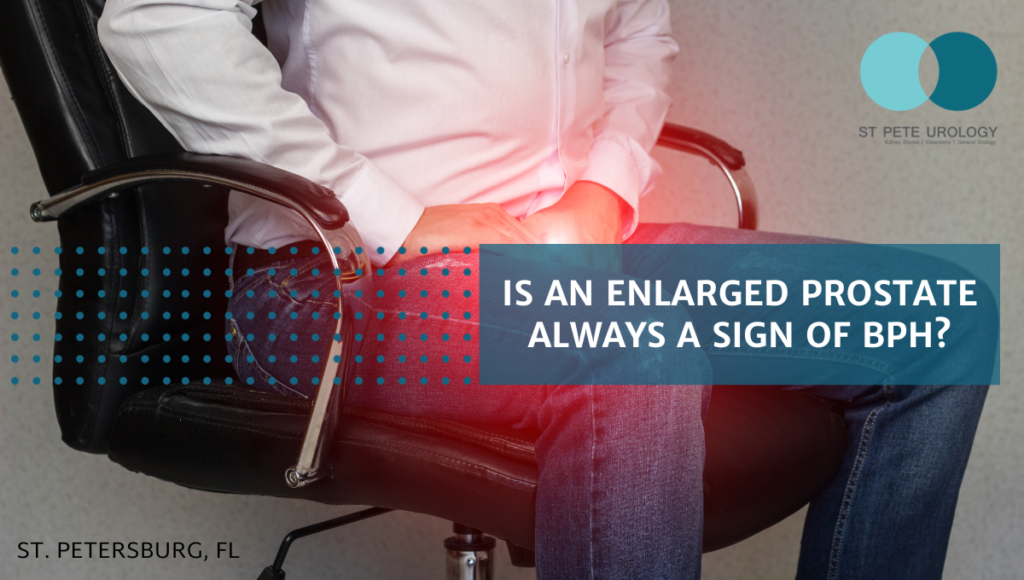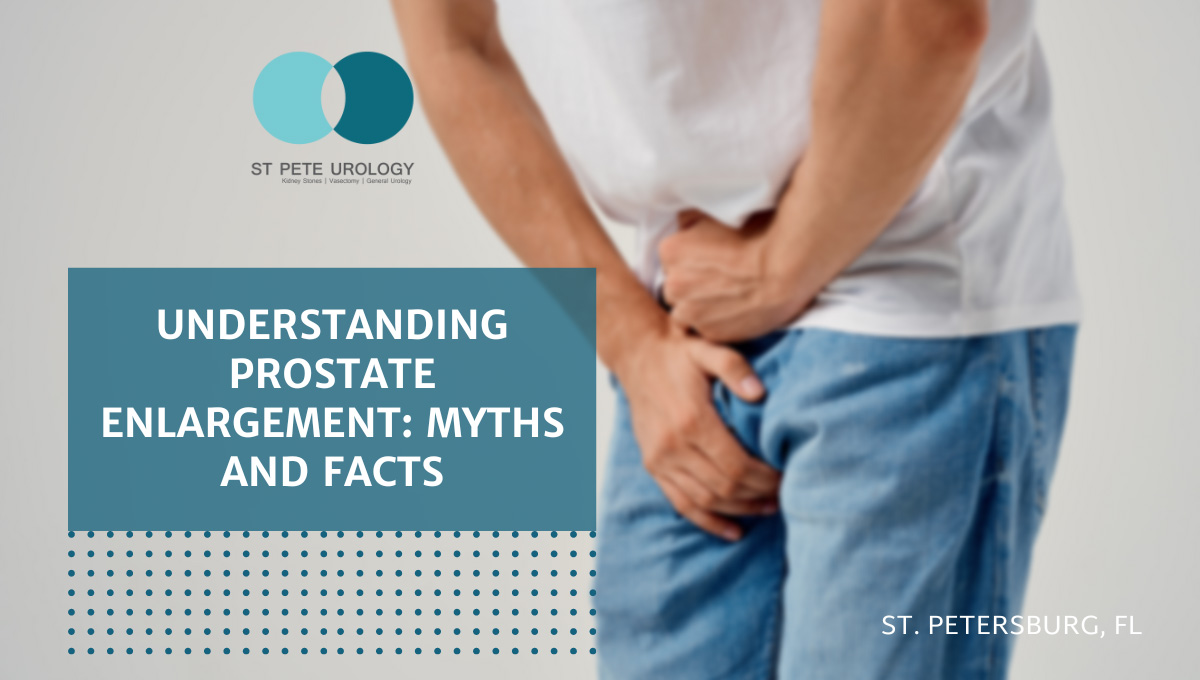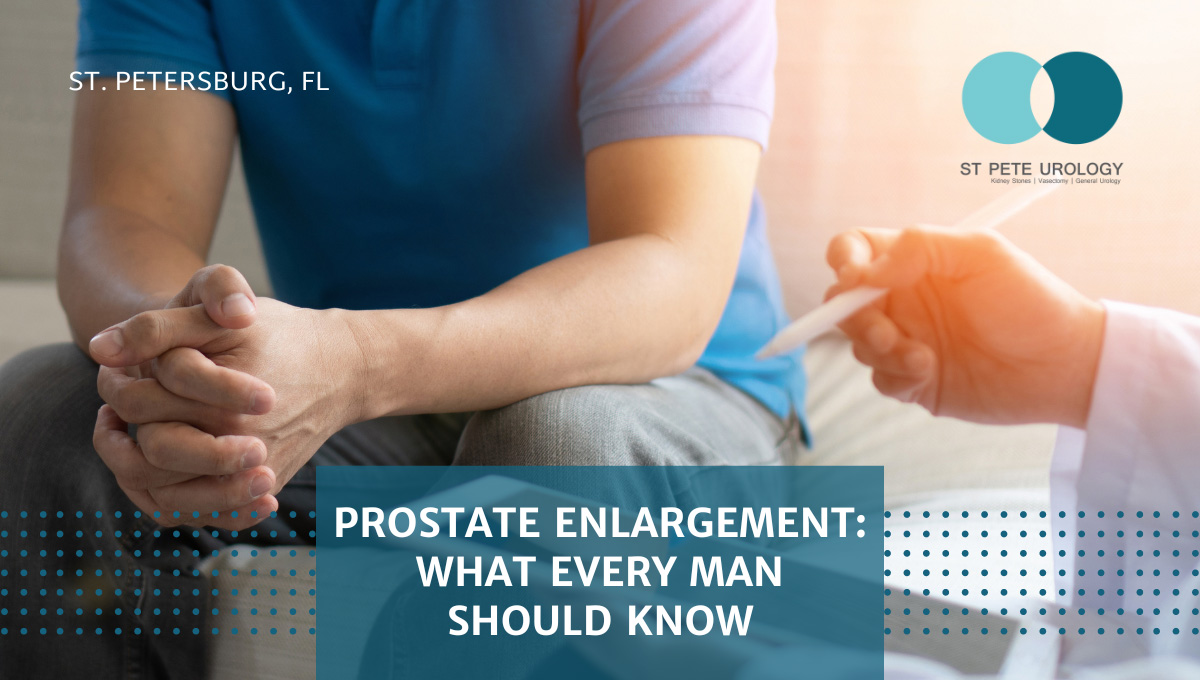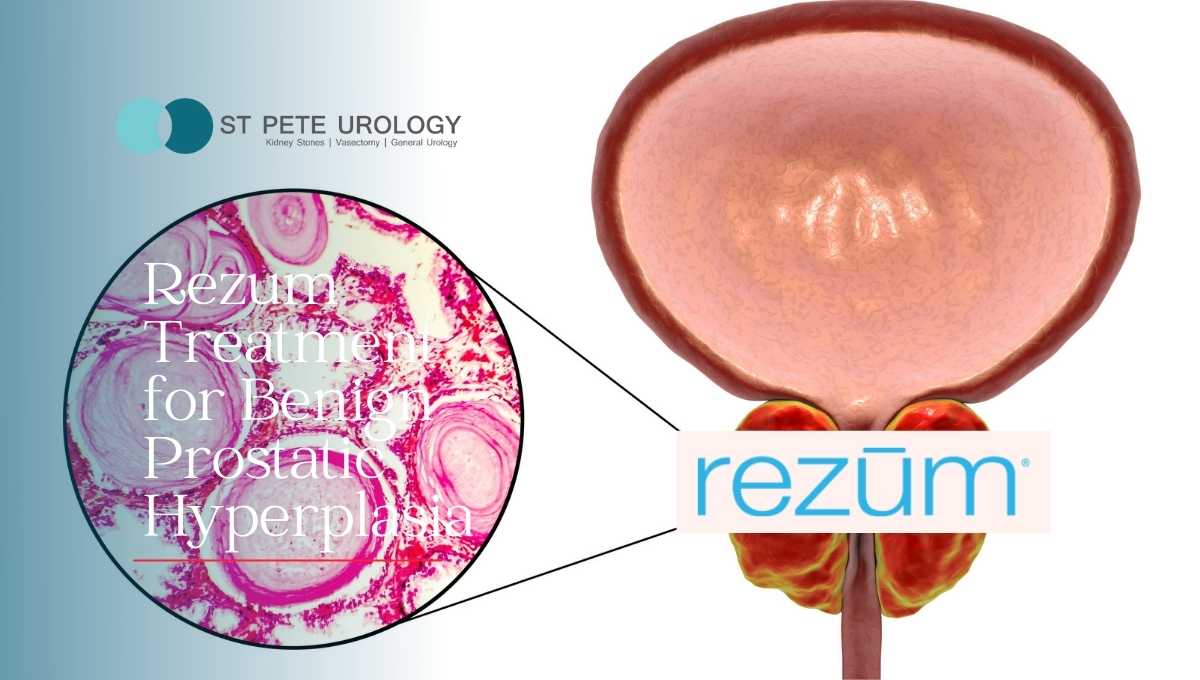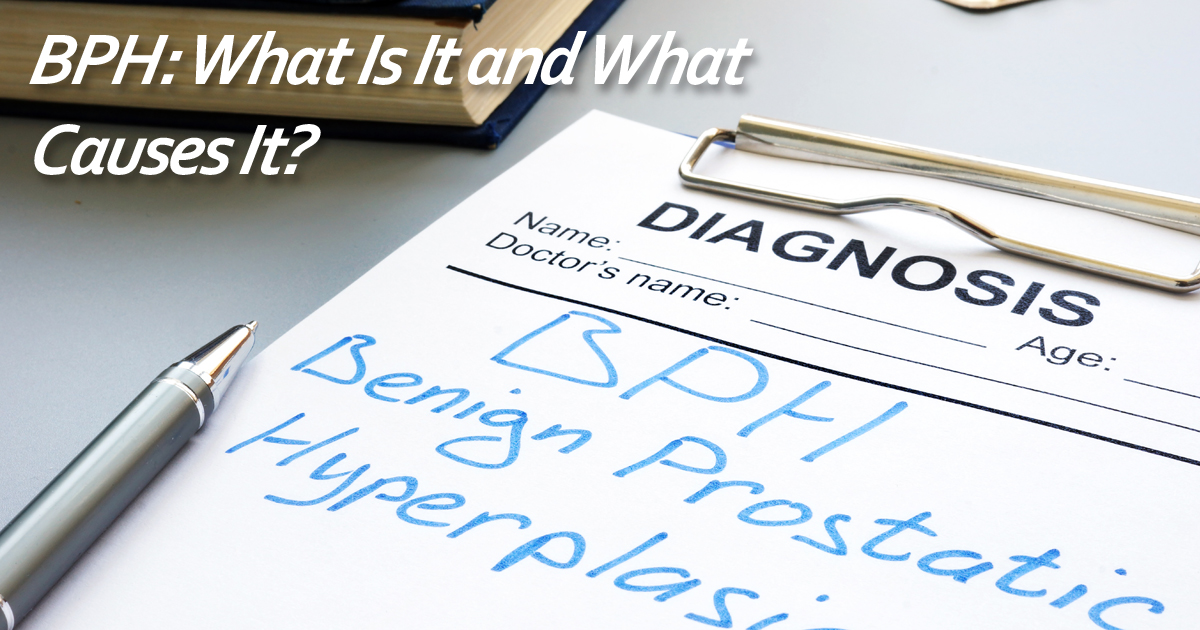How effective are non-surgical treatments for BPH? Understanding these treatments is a complex one, so find out more with St. Pete Urology.
Continue readingBPH (Enlarged Prostate): What Is It?
What is BPH or Enlarged Prostate? BPH is a condition that will affect the prostate of nearly every man at some point after the age of 40.
Continue readingIs an Enlarged Prostate Always a Sign of BPH?
Understanding Prostate Enlargement: Myths and Facts
How much of what you hear about prostate enlargement is true? Learn about the myths and misconceptions about prostate enlargement or BPH.
Continue readingProstate Enlargement: What Every Man Should Know
By the time you reach the golden age of fifty and beyond, it’s not uncommon to experience symptoms of an enlarged prostate. Learn more here.
Continue readingRezum Treatment for Benign Prostatic Hyperplasia
Benign prostatic hyperplasia (BPH), also called enlarged prostate, is a frustrating condition commonly occurring as men grow older.
Continue readingBPH: What Is It and What Causes It?
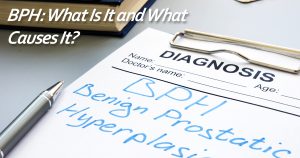

It is important to note that the size of the prostate does not necessarily correlate to the enlargement of the prostate. For instance, some men may have prostates that are only slightly enlarged and still suffer from symptoms worse than men with far greater enlarged prostates.
The prostate gland is found just below the bladder, and the tube that allows urine to exit the body runs directly through it. This is why urine flow is affected when the prostate enlarges. The primary cause of BPH is not fully known, but it may be related to changing sex hormone levels in men as they age.
The main risk factor for BPH is aging. Although BPH rarely affects men under 40, one-third of men between the ages of 40 and 60 experience it. And half of men experience it by age 80. Family history also plays a role in your chances of developing these problems. Men with a blood relative with BPH are more likely to develop it themselves. Diabetes, heart disease and obesity all increase the risk factors as well, while exercise helps lower them.
There are several complications that can result from BPH. The most common one is the inability to urinate, which may require a catheter if severe enough. Urinary tract infections can occur as well. Bladder stones and bladder damage may occur when the bladder cannot be fully emptied, which is more likely to happen to someone with BPH. Kidney damage is another complication that occurs when pressure that has built up in the bladder directly damages the kidneys.
Although common, BPH is a serious condition that can negatively affect quality of life and well being. But with many treatment options available, men can find relief by promptly seeking medical help. The doctors at St Pete Urology specialize in treating these issues and improving the lives of men as they age. For more information, visit the St Pete Urology website or make an appointment for a consultation.
GreenLight PVP Laser, a Great Treatment Option for BPH
Photo-selective Vaporization of Prostate (PVP) is increasingly becoming a popular method of treating benign prostatic enlargement (enlarged prostate or BPH). Using a combination of a high-powered laser beam and fiber optics to vaporize overgrowths of cells in the prostate, PVP helps to shrink the prostate gland quickly and accurately and swiftly relieves symptoms of Benign Prostatic Hyperplasia. The GreenLight Laser PVP is an alternative to the more common TURP (Transurethral Resection of Prostate). While the PVP procedure offers equal effectiveness in improving BPH symptoms, it’s simpler, has minimal short-term side effects, and offers quicker symptom relief, comfort and ease of urine flow.
How Is The Procedure Performed?
Conducted as an outpatient procedure by a urologist trained in the technique, the GreenLight Laser PVP requires nerve-blocking, spinal or general anesthesia along with sedation. During the procedure, the urologist inserts a cystoscope (tube supplied with light) via the urethra into the prostate, then runs a thin fiber through the cystoscope and places it in the urethra just adjacent to the obstruction. The urologist directs the laser at the prostate with intense pulses of light radiating from the ends of the fiber that are absorbed by blood.
As the blood absorbs light its temperature increases rapidly, heating up and vaporizing nearby cells. The surgeon continues to apply the laser light to destroy tissue overgrowth and reduce restriction on the urethra. The tissue that’s evaporated seals the blood vessels and reduces bleeding. The procedure takes roughly 40-60 minutes and a temporary catheter is usually inserted to help drain urine from the bladder.
So what are the benefits of Laser PVP?
- Minimal bleeding.
- Patients return home the same day.
- Return to normal activities in 2-3 days with caution.
- Only about 30 percent of patients require a post-op catheter.
- Return to strenuous activities in 4-6 weeks.
- Complications are rare, but quite mild if they occur.
- No post-operative impotence.
- PVP has not been associated with erectile dysfunction.
- Less likely to cause retrograde ejaculation.
- Lasting improvement in urine flow.
- Urinary obstruction is less likely with PVP.
Recovery after GreenLight Laser PVP
After laser PVP, patients remain in a recovery area where they are observed and prepared for discharge, typically within a few hours. If a temporary catheter is inserted, it’s usually removed 2-3 days after treatment, but may be left for a longer period in men who have had very severe symptoms or suffered prior bladder damage. During the first week following the procedure, a slight burning and discomfort may be experienced when urinating and small amounts of blood may occur in urine. While a dramatic improvement of symptoms and urine flow occurs within 1-2 days after the procedure, patients may still experience frequency and a sudden urge to pass urine for some time after treatment since the urethra is still adjusting to changes. And those with multiple health problems may not realize improvement that quickly.
Many men resume normal activities three days or so after laser PVP, but it’s recommended that they refrain from heavy lifting, pushing, strenuous exercise and vibrating equipment for at least 2 weeks because such activities may aggravate the urogenital area and cause bleeding. Sexual activity should be avoided for 2-3 weeks and only resumed when the patient is really comfortable doing so. It’s crucial to take things slowly and realize that it’ll take a while to get everything back to normal, including sexual desire. At times, retrograde ejaculation or reduced volume may occur, but these do not affect sexual pleasure or orgasm.
Is Laser PVP Safe?
The GreenLight Laser PVP is a significant improvement on the other minimally-invasive procedures used to treat BPH. It accurately vaporizes the overgrowth of the prostate gland without damaging any surrounding tissues and vessels. High-powered energy beams are delivered through a very thin laser fiber resulting in safe and precise vaporization of the overgrown tissue that’s blocking normal urine flow. As the high-pulsed laser removes the tissue causing blockage, it coagulates blood vessels and minimizes bleeding. Compared to other options for treating BPH, the GreenLight Laser PVP is much safer, simpler, faster, more precise and more effective. And most importantly, it allows quicker recovery than the other treatment options.
How does laser PVP compare with TURP?
Previously, effective BPH treatment required open prostatectomy — a major abdominal operation that needed a longer hospital stay and several months for recovery. But with the availability of instruments for accessing the prostate via the urethra instead of through the abdomen, TURP (transurethral resection of prostate) became the preferred treatment as it offered more safety, efficiency and effectiveness. However, there was still need for a better treatment that could offer quicker results, shorter recovery times and fewer long-term side-effects. The GreenLight Laser PVP has proven an improvement on TURP by being less invasive, delivering more immediate results and providing shorter recovery periods.
At St Pete Urology, we recommend transurethral vaporization procedures, most commonly the PVP GreenLight Laser and HoLAP (Holmium Laser Ablation), as alternatives for the previous gold standard TURP (Transurethral Resection of Prostate) because they are minimally-invasive outpatient operations with lower risks, durable results, safe use on large glands and patients on blood thinners, and high patient satisfaction. We perform the PVP GreenLight Laser on patients eligible for TURP, but discuss all the treatment options with our patients before we make a choice. For more information on treatment and care for BPH, visit the “St Pete Urology” site.
What is BPH
Benign Prostatic Enlargement (BPH) is an age-related, non-cancerous growth of the prostate. BPH is a common condition, particularly in older men. In fact, almost every man will suffer from the symptoms of the condition at some point after the age of 40; with more than 70 percent of men over 60 having symptoms of BPH while 90 percent of men over 85 years have the condition. As the prostate gets larger, it presses hard on the urethra causing urethra blockage and bothersome urinary symptoms. However, BPH is not cancer and does not make a man more likely to get prostate cancer.
Phases of prostate growth
Located in front of the rectum and between the penis and the bladder, the prostate is a small, walnut-sized gland that secretes the prostatic fluid, one of the key components of semen. Typically, the prostate goes through two major growth phases during a man’s lifetime. The first growth phase takes place during puberty when the prostate usually doubles in size. Beyond puberty, often at around the age of 25, the prostate begins to grow again and continues to do so for the rest of life in many men. This continuous growth is what leads to BPH and makes the condition quite frequent in older men. BPH does not occur in men until the second phase of prostate growth when the gland begins to press on the urethra and causes urinary problems.
Causes of BPH
As a man gets older, the balance between self-proliferation of cells and cell-death becomes harder to maintain due to changes in hormone levels (androgens), cell-to-cell communication (cell signaling pathways) and growth factors. The cells of the prostate multiply rapidly and form microscopic nodules, which then continue to grow. The abnormal and uncontrolled increase in the number of prostate cells is called hyperplasia. The microscopic nodules increase in mass and volume, resulting in an enlarged prostate. This abnormal growth occurs in the transitional zone around the urethra and is characterized by increase in size without becoming cancerous.
Symptoms of BPH
As the prostate increases in size, it begins to squeeze more tightly on the urethra. This makes it difficult for the bladder to fully compensate for the resulting pressure and reduces its ability to empty completely. Urine flow problems may result, including:
- Difficulty starting urination.
- Dribbling of urine, often after urinating.
- Weak urine stream (peeing in stops and starts).
As the urethra is squeezed by the enlarged prostate, it becomes difficult for the bladder to push out urine. Over time, the bladder muscles are weakened as they push harder to empty urine. This in turn makes it more difficult for the bladder to empty, resulting in:
- Frequency, urinating too often, typically eight or more times per day.
- Incontinence, lack of control over when to pass urine.
- Urgency, sudden need to urinate.
- Nocturia, waking up several times each night to pass urine.
- Urinary retention, a sense that you are not fully emptying your bladder.
- Urine leakage.
In some cases, BPH may lead to backing up and stagnation of urine, which may in turn result in bladder stones, recurring urinary tract infections, bladder divericulae and kidney or bladder damage. The condition also may lead to a sudden inability to pass urine (acute urinary retention), a very painful medical emergency requiring urgent drainage.
When Should You See a Doctor?
Symptoms of BPH vary from person to person. Some men with the condition have few or no issues while others experience severe symptoms. Generally, treatment for BPH may be optional when the symptoms are mild and no complications exist. So if the symptoms do not bother you enough to take medications or go through a procedure for it, then you may only need to speak with your doctor to make sure that your symptoms are stable and your bladder empties well. However, if you experience complications such as a burning sensation when urinating, bladder pain when urinating, blood in urine accompanied by chills and fever or nausea and vomiting, acute urinary retention or lower back pain, then you must seek immediate medical attention.
Treatment for BPH
There are many treatment options for BPH. If you are diagnosed with this condition, talk to your doctor to find out the right treatment for you. The most common treatments include medications (such as alpha reductase inhibitors), UroLift System treatment, thermotherapies (using heat energy such as radiofrequency or microwave), laser resection and transurethral resection. The treatment recommended by your doctor will depend on the severity of your symptoms, the extent to which the symptoms affect your life and the presence of other medical disorders.
Looking for the best urology center for safe and effective treatment? At St Pete Urology, we have built a reputation for exceptional and excellent diagnosis and treatment of BPH and other urological conditions using medical and surgical interventions. Through our skillful and experienced urologists, nurses and technicians, we deliver comprehensive, compassionate and patient-centered treatment and care to all our patients. We use state-of-the-art surgical and medical techniques to deliver timely, safe and effective treatment. For more information on the diagnosis and treatment of BPH and other urological disorders, visit the “St Pete Urology” site.
Prostate Enlargement BPH
Prostate enlargement (Benign Prostatic Hyperplasia) is a medical condition characterized by increase in the size of the prostate gland without becoming cancerous. So the prostate grows bigger but the cells do not become cancerous. The prostate is an essential organ in the male reproductive system, secreting the prostate fluid that forms part of semen. In childhood, the prostate is a small, walnut-sized gland and maintains this size up to puberty. During early puberty, the prostate undergoes the first phase of growth which doubles its size. Later on, at about age 25, the prostate starts to undergo a second phase of growth which continues for the rest of a man’s life. It is during this second phase of growth that benign prostatic enlargement (BPH) occurs.
How prostate size varies with age
By the age of 20, average males have a walnut-sized prostate and very few prostate-related health concerns. However, around 40, many men begin to experience issues related to prostate enlargement. By the age of 50, around 50 percent of all men have health concerns related to BPH. And at 60 and beyond, the prostate continues to grow and press against the urethra, reducing the size of the urethra and obstructing the flow of urine. Men in their 60s may experience mild inconvenience or serious lifestyle disruptions such as lack of sleep due to difficult or frequent nighttime urination as pressure is applied on the bladder and urethra by the inflamed prostate. By the age of 80, around 80 percent of men experience symptoms of prostate enlargement. In fact, the symptoms are so common beyond the age of 80 that almost all men will experience them if they live long enough.
Symptoms of prostate enlargement
As the prostate increases in size, it presses against the urethra and causes the size of the urethra to reduce. The narrowing of the urethra causes the bladder to thicken, weaken and lose the ability to empty fully, resulting in urinary retention. The urinary retention in the bladder and the tightening of the urethra causes several urinary tract problems, such as:
- Difficulty in starting a urine stream.
- Difficulty emptying the bladder.
- Urinary urgency, being unable to delay urination.
- Urinary frequency, passing urine eight or more times per day.
- Nocturia, passing urine during periods of night sleep.
- Interrupted or weak urine stream.
- Dribbling after passing urine.
- Pain during urination or after ejaculation.
- Urinary incontinence, accidental loss of urine.
- Unusual smell or color of urine.
Treatment of prostate enlargement
The right treatment for benign prostate enlargement varies from patient to patient depending on the severity of the symptoms, the extent to which the symptoms affect a man’s life, presence of other medical conditions and the patient’s preferences. A man may not need treatment for a mild prostate enlargement unless he has bothersome symptoms that are affecting the quality of his life. However, in cases where no treatment is administered, regular checkups are recommended.
If the benign prostatic hyperplasia is causing severe, bothersome symptoms or presents a serious health risk, then the urologist would recommend treatment, such as medications (using alpha blockers, 5-alpha reductase inhibitors, phosphodiesterase-5 inhibitors or combination medications), minimally-invasive procedures (like transurethral needle ablation, transurethral microwave thermotherapy, high-intensity focused ultrasound, transurethral electro-vaporization, water-induced thermotherapy or prostatic stent insertion) and surgery (transurethral resection, laser surgery, transurethral incision or prostatectomy) for long-term treatment.
Are you a man age 40 or older who is worried about your risk of prostate enlargement? Would you like a session with some of the best, world-renowned urologists to help you find relief from your prostate enlargement symptoms? At St Pete Urology, we have tailored our urology services to meet the diverse needs of our patients. We have assembled a great team of urologists, nurses and technologists to help us deliver prompt, safe and effective treatment of urological disorders. We use the latest technology and techniques to guarantee utmost convenience, safety, comfort and efficacy of all our procedures. Visit us today for help with your BPH symptoms. For more information on the diagnosis, treatment and care for prostate enlargement, visit the “St Pete Urology” site.

